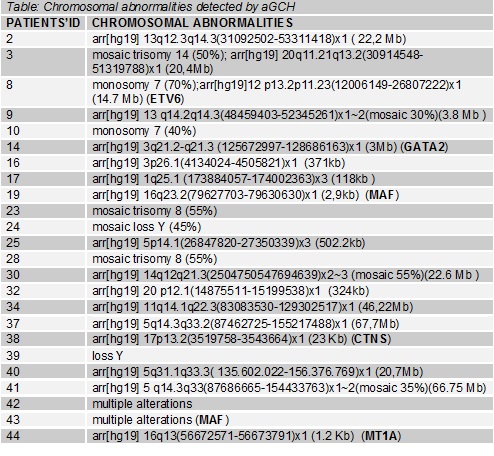GenOMec – University of Siena, Italy

Contributions
Type: Publication Only
Background
The diagnosis of MDS is determined by bone marrow’s histology and is integrated by conventional cytogenetic (CC) analyses that, although, are unable to show chromosomal abnormalities in about 30% of cases. Array Comparative Genomic Hybridization (aCGH) detects copy number aberrations in half of MDS diploid by CC. Recently, TET2, ASXL1, EZH2, CBL, IDH1/IDH2, DNMT3A, and UTX mutations have been described in MDS.
Aims
Therefore, we evaluated the prognostic and predictive implications of FISH, aCGH and mutation assays when added to CC.
Methods
Fifty patients, 15 females and 35 males, with a median age of 72-year (range 39-88) were enrolled in a single institution (Hematology Unit, University of Pisa, Italy), between March 2013 and October 2014. Patients’ prognosis was determined according to IPSS in low (42%), intermediate-1 (33%), intermediate-2 (17%) and high risk (8%). Samples were evaluated by CC including, conventional karyotyping and FISH for chromosome 5, 7, PDGFRA, and PDGFRB. Moreover, aCGH was performed using SurePrint G3 Human CGH Microarray, 8x60K (Agilent), and mutations of TET2, TP53, ASXL1, and EZH2 were determined using qBiomarker somatic mutation PCR array (Qiagen).
Results
After FISH analysis, additional copy number losses of chromosome 3 and 5 were observed in 1 and 2 cases, respectively. According to aCGH, 20 patients (40%) showed copy number aberrations (Table). Seventeen patients had a mutation: 12 in TP53, 4 in ASXL1 and 1 in TET2 sequence.
Summary
1) The study showed the reduction of CC failures (only 16%);
2) Because of FISH results, a patient received azacitidine and another one lenalidomide;
3) Three MDS patients with copy number aberrations detected exclusively by aCGH progressed in acute leukemia being lethal: one patient had copy number loss of chromosome 3, one had copy number losses of chromosomes 8 and Y and the last one had copy number loss of ETV6 locus.
4) One patient with TET2 mutation did not respond to the azacitidine. Three out of 4 patients with ASXL1 mutation had a good response to epoietin. TP53 mutations were observed in 12 cases of which 2 developed acute leukemia, 2 were resistant, and 2 sensitive to epoetin.
In conclusion, our results support the relevance of an integrated work-up for MDS and provide a preliminary estimation of copy number aberration and mutation frequencies. The prognostic role of aCGH and somatic mutations needs to be determined in properly sized series.

Session topic: Publication Only
Type: Publication Only
Background
The diagnosis of MDS is determined by bone marrow’s histology and is integrated by conventional cytogenetic (CC) analyses that, although, are unable to show chromosomal abnormalities in about 30% of cases. Array Comparative Genomic Hybridization (aCGH) detects copy number aberrations in half of MDS diploid by CC. Recently, TET2, ASXL1, EZH2, CBL, IDH1/IDH2, DNMT3A, and UTX mutations have been described in MDS.
Aims
Therefore, we evaluated the prognostic and predictive implications of FISH, aCGH and mutation assays when added to CC.
Methods
Fifty patients, 15 females and 35 males, with a median age of 72-year (range 39-88) were enrolled in a single institution (Hematology Unit, University of Pisa, Italy), between March 2013 and October 2014. Patients’ prognosis was determined according to IPSS in low (42%), intermediate-1 (33%), intermediate-2 (17%) and high risk (8%). Samples were evaluated by CC including, conventional karyotyping and FISH for chromosome 5, 7, PDGFRA, and PDGFRB. Moreover, aCGH was performed using SurePrint G3 Human CGH Microarray, 8x60K (Agilent), and mutations of TET2, TP53, ASXL1, and EZH2 were determined using qBiomarker somatic mutation PCR array (Qiagen).
Results
After FISH analysis, additional copy number losses of chromosome 3 and 5 were observed in 1 and 2 cases, respectively. According to aCGH, 20 patients (40%) showed copy number aberrations (Table). Seventeen patients had a mutation: 12 in TP53, 4 in ASXL1 and 1 in TET2 sequence.
Summary
1) The study showed the reduction of CC failures (only 16%);
2) Because of FISH results, a patient received azacitidine and another one lenalidomide;
3) Three MDS patients with copy number aberrations detected exclusively by aCGH progressed in acute leukemia being lethal: one patient had copy number loss of chromosome 3, one had copy number losses of chromosomes 8 and Y and the last one had copy number loss of ETV6 locus.
4) One patient with TET2 mutation did not respond to the azacitidine. Three out of 4 patients with ASXL1 mutation had a good response to epoietin. TP53 mutations were observed in 12 cases of which 2 developed acute leukemia, 2 were resistant, and 2 sensitive to epoetin.
In conclusion, our results support the relevance of an integrated work-up for MDS and provide a preliminary estimation of copy number aberration and mutation frequencies. The prognostic role of aCGH and somatic mutations needs to be determined in properly sized series.

Session topic: Publication Only


